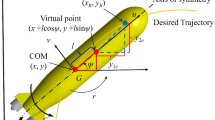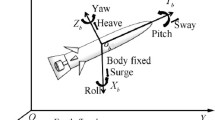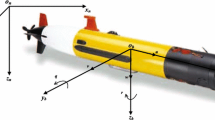Abstract
In this paper, a new approach to stability analysis of nonlinear dynamics of an underactuated autonomous underwater vehicle (AUV) is presented. AUV is a highly nonlinear robotic system whose dynamic model includes coupled terms due to the hydrodynamic damping factors. It is difficult to analyze the stability of a nonlinear dynamical system through Routh’s stability approach because it contains nonlinear dynamic parameters owing to hydrodynamic damping coefficients. It is also difficult to analyze the stability of AUVs using Lyapunov’s criterion and LaSalle’s invariance principle. In this paper, we proposed the extended-Routh’s stability approach to verify the stability of such nonlinear dynamic systems. This extended-Routh’s stability approach is much easier as compared to the other existing methods. Numerical simulations are presented to demonstrate the efficacy of the proposed stability verification of the nonlinear dynamic systems, e.g., an AUV system dynamics.
Similar content being viewed by others
References
D. J. Stilwell, B. E. Bishop. Platoons of underwater vehicles. IEEE Control Systems, vol. 20, no. 6, pp. 45–52, 2000.
R. W. Beard, J. Lawton, F. Y. Hadaegh. A coordination architecture for spacecraft formation control. IEEE Transactions on Control Systems Technology, vol. 9, no. 6, pp. 777–790, 2001.
D. P. Scharf, F. Y. Hadaegh, S. R. Ploen. A survey of spacecraft formation flying guidance and control (part I): Guidance. In Proceedings of American Control Conference, IEEE, Denver, USA, pp. 1733–1739, 2003.
Y. S. Kim, J. Lee, S. K. Park, B. H. Jeon, P. M. Lee. Path tracking control for underactuated AUVs based on resolved motion acceleration control. In Proceedings of the 4th International Conference on Autonomous Robots and Agents, IEEE, Wellington, New Zealand, pp. 342–346, 2009.
B. Subudhi, K. Mukherjee, S. Ghosh. A static output feedback control design for path following of autonomous underwater vehicle in vertical plane. Ocean Engineering, vol. 63, pp. 72–76, 2013.
B. K. Sahu, B. Subudhi. Adaptive tracking control of an autonomous underwater vehicle. International Journal of Automation and Computing, vol. 11, no. 3, pp. 299–307, 2014.
B. K. Sahu, B. Subudhi. The state of art of Autonomous Underwater Vehicles in current and future decades. In Proceedings of the 1st International Conference on Automation, Control, Energy and Systems, IEEE, Hooghey, India, pp. 1–6, 2014.
B. K. Sahu, B. Subudhi. Potential function-based pathfollowing control of an autonomous underwater vehicle in an obstacle-rich environment. Transactions of the Institute of Measurement and Control, 2016, DOI: 10.1177/0142331216634424. (in Press)
D. T. Liu, W. P. Guo, J. Q. Yi. Dynamics and GA-based stable control for a class of underactuated mechanical systems. International Journal of Control Automation and Systems, vol. 6, no. 1, pp. 35–43, 2008.
R. W. Beard, J. Lawton, F. Y. Hadaegh. A feedback architecture for formation control. In Proceedings of the American Control Conference, IEEE, Chicago, USA, vol. 6, pp. 4087–4091, 2000.
F. Dorfler, B. Francis. Geometric analysis of the formation problem for autonomous robots. IEEE Transactions on Automatic Control, vol. 55, no. 10, pp. 2379–2384, 2010.
F. Fahimi. Sliding-mode formation control for underactuated surface vessels. IEEE Transactions on Robotics, vol. 23, no. 3, pp. 617–622, 2007.
D. B. Gu, H. S. Hu. Using fuzzy logic to design separation function in flocking algorithms. IEEE Transactions on Fuzzy Systems, vol. 16, no. 4, pp. 826–838, 2008.
D. B. Gu, Z. Y. Wang. Leader-follower flocking: Algorithms and experiments. IEEE Transactions on Control Systems Technology, vol. 17, no. 5, pp. 1211–1219, 2009.
R. O. Saber, W. B. Dunbar, R. M. Murray. Cooperative control of multi-vehicle systems using cost graphs and optimization. In Proceedings of American Control Conference, IEEE, Denver, USA, vol. 3, pp. 2217–2222, 2003.
T. Balch, R. C. Arkin. Behavior-based formation control for multirobot teams. IEEE Transactions on Robotics and Automation, vol. 14, no. 6., pp. 926–939, 1998.
A. Gelb, W. E. V. Velde. Multiple Input Describing Functions and Nonlinear System Design, New York, USA: McGraw-Hill, 1968.
S. T. Impram, N. Munro. Stability of nonlinear systems with complex disc and norm-bounded perturbations. In Proceedings of American Control Conference, IEEE, Chicago, USA, vol. 5, pp. 3111–3115, 2000.
N. Tan, D. P. Atherton. A new approach to the stability of nonlinear systems with uncertain plant parameters. In Proceedings of the American Control Conference, IEEE, Denver, USA, vol. 3, pp. 1843–1848, 2003.
S. Wu, G. Manke. Popov criterion and Lagrange stability of nonlinear systems. IEEE Transactions on Automatic Control vol. 12, no. 5, pp. 627, 1967.
L. Socha. Frequency-domain criteria for stability of a class of nonlinear systems with random parameters. IEEE Transactions on Automatic Control, vol. 20, no. 2, pp. 284–287, 1975.
Y. P. Liu, L. P. Wang, P. Mei, K. Hu. Stability analysis of bipedal robots using the concept of Lyapunov exponents. Mathematical Problems in Engineering, vol. 2013, Article number 546520, 2013.
E. F. Yang, D. B. Gu. Nonlinear formation-keeping and mooring control of multiple autonomous underwater vehicles. IEEE/ASME Transactions on Mechatronics, vol. 12, no. 2, pp. 164–178, 2007.
W. J. Mao, J. Chu. Robust D-stability and D-stabilization of dynamic interval systems. International Journal of Control Automation and Systems, vol. 5, no. 5, pp. 594–600, 2007.
D. B. Gu, Z. Y. Wang. Leader-follower flocking: Algorithms and experiments. IEEE Transactions on Control Systems Technology, vol. 17, no. 5, pp. 1211–1219, 2009.
L. Sentis, J. Petersen, R. Philippsen. Implementation and stability analysis of prioritized whole-body compliant controllers on a wheeled humanoid robot in uneven terrains. Autonomous Robots, vol. 35, no. 4, pp. 301–319, 2013.
F. Repoulias, E. Papadopoulos. Planar trajectory planning and tracking control design for underactuated AUVs. Ocean Engineering, vol. 34, no. 11–12, pp. 1650–1667, 2007.
S. P. Hou, C. C. Cheah. Can a simple control scheme work for a formation control of multiple autonomous underwater vehicles. IEEE Transactions on Control Systems Technology, vol. 19, no. 5, pp. 1090–1101, 2011.
D. B. Gu, Z. Y. Wang. Leader-follower flocking: Algorithms and experiments. IEEE Transactions on Control Systems Technology, vol. 17, no. 5, pp. 1211–1219.
M. Bjerkeng, P. Falco, C. Natale, K. Y. Pettersen. Discretetime stability analysis of a control architecture for heterogeneous robotic systems. In Proceedings of IEEE/RSJ International Conference on Intelligent Robots and Systems, IEEE, Tokyo, Japan, pp. 4778–4783, 2013.
X. M. Tang, J. S. Yu. Stability analysis of discrete-time systems with additive time-varying delays. International Journal of Automation and Computing, vol. 7, no. 2, pp. 219–223, 2010.
M. Bjerkeng, P. Falco, C. Natale, K. Y. Pettersen. Stability analysis of a hierarchical architecture for discrete-time sensor-based control of robotic systems. IEEE Transactions on Robotics, vol. 30, no. 3, pp. 745–753, 2014.
R. Matousek, I. SVarc. Simple methods for stability analysis of nonlinear control systems. In Proceedings of the 13th WSEAS International Conference on Systems, ACM, San Francisco, USA, pp. 226–231, 2009.
H. K. Khalil. Nonlinear Systems, 3rd ed., Upper Saddle River, USA: Prentice Hall, 2002.
W. M. Haddad, V. S. Chellaboina. Nonlinear Dynamical Systems and Control: A Lyapunov-Based Approach. Princeton, USA: Princeton University Press, 2008.
E. Lavretsky. Control and Dynamical Systems, California Institute of Technology, [Online], Available: http://www.cds.caltech.edu/archive/help/uploads/wiki/ files/204/Lectures1-2 CDS270.pdf.
B. K. Sahu, M. M. Gupta, B. Subudhi. Extended-Routh’s approach for the stability analysis of nonlinear discrete time systems. In Proceedings of International Conference on Signal Processing, Computing and Control, IEEE, Solan, India, pp. 1–5, 2013.
K. Y. Song, M. M. Gupta, N. Homma. Design of an errorbased adaptive controller for a flexible robot arm using dynamic pole motion approach. Journal of Robotics, vol. 2011, Article number 726807, 2011.
B. K. Sahu, M. M. Gupta, B. Subudhi. Stability analysis of nonlinear systems using dynamic-Routh’s stability criterion: A new approach. In Proceedings of International Conference on Advances in Computing, Communications and Informatics, IEEE, Mysore, India, pp. 1765–1769, 2013.
G. R. Chen. Stability of nonlinear systems. Encyclopedia of RF and Microwave Engineering, J. G. Webster, Ed., New York, USA: Wiley, pp. 4881–4896, 2004.
T. I. Fossen. Guidance and Control of Ocean Vehicles, New York, USA: John Wiley and Sons, 1994.
Acknowledgement
The authors wish to thank the editor and the reviewers for their suggestions to improve the quality of the paper.
Author information
Authors and Affiliations
Corresponding author
Additional information
This work was supported by Naval Research Board (NRB), Defense Research Development Organization (DRDO), Government of India (No. DNRD/05/4003/NRB/160).
Recommended by Associate Editor Min Cheol Lee
Basant Kumar Sahu received the M.Tech. degree in electronics design technology from Tezpur Central University, India in 2008. He was awarded the Canadian Commonwealth Scholarship by the Canadian Bureau for International Education for pursuing a short term research in the University of Saskatchewan, Canada in 2012, where he continued research work from 2012 to 2013. He received the Ph.D. degree at the Department of Electrical Engineering, National Institute of Technology (NIT) Rourkela, India in 2015. He is working as an associate professor in the Department of Electrical Engineering, National Institute of Science and Technology, India.
His research interests include nonlinear control, underwater vehicle control, robotics and intelligent control.
Bidyadhar Subudhi received the B.Eng. degree in electrical engineering, from NIT Rourkela, India in 1988, the M.Tech. degree in control and instrumentation from Indian Institute of Technology Delhi (IIT Delhi), India in 1993, and the Ph.D. degree in control system engineering from University of Sheffield, UK in 2003. He is a professor at the Department of Electrical Engineering, National Institute of Technology Rourkela, India. He has been a post-doctoral research fellow in the Department of electrical and computer engineering, National University of Singapore (NUS), Singapore during May to November of 2005. He was a visiting professor at University of Saskatchewan, Canada during May to June, 2009, and also at Asian Institute of Technology (AIT), Bangkok during January to May, 2013. He is currently the coordinator of Centre of Excellence, Renewable Energy System, Centre of Excellence, Industrial Electronics and Robotics and Dean (Alumni Relation) NIT Rourkela. He is also the principal investigator in several research projects funded by Defense Research Development Organization (DRDO), Council of Scientific and Industrial Research (CSIR) and Department of Science and Technology (DST), including the international cooperation projects under UK India Education Research Initiative (UKIERI) and Department of Science & Technology (DST)–Government of India and Ministry of Education and Science (RMES) schemes. He has published 83 journal papers in prestigious journals such as IEEE transactions, Institution of Engineering and Technology (IET): Control Theory and Applications and Elsevier, and presented 70 research papers in many international conferences both in India and abroad. He has edited one book and contributed 3 book chapters. He chaired a number of technical sessions at international conferences. He is a fellow of the IET (UK) and a senior member of IEEE (USA). He is a regular reviewer of IEEE Translations on Systems, Man and Cybernetics, Power Delivery, Control System Technology, Neural Networks and Automatic Control.
His research interests include system identification and adaptive control, networked control system, control of flexible and underwater robots, control of renewable energy systems, estimation and filtering with application to power system.
Madan Mohan Gupta received the B. Eng. (Hons.), and the M. Eng. degrees in electronics-communications engineering and control systems from the Birla Engineering College (now the Birla Institute of Technology & Science), India in 1961 and 1962, respectively. He received the Ph.D. degree in adaptive control systems from University of Warwick, UK in 1967. He is the fellow of the Institute of Electrical and Electronics Engineers (IEEE). He was also elected as a fellow of the International Society for Optical Engineering (SPIE) for his contributions to the field of neuro-control and neuro-fuzzy systems. He was also elected fellow of the International Fuzzy Systems Association (IFSA) for his contributions to the field of fuzzy-neural computing systems. He is the professor emeritus of mechanical engineering, director of Intelligent Systems Research Laboratory, College of Engineering, University of Saskatchewan, Canada. He has authored or co-authored over 900 published research papers. He has recently co-authored the seminal book Static and Dynamic Neural Networks: From Fundamentals to Advanced Theory. He has previously co-authored Introduction to Fuzzy Arithmetic: Theory and Applications (the first book on fuzzy arithmetic) and Fuzzy Mathematical Models in Engineering and Management Science. Both of these books have Japanese translations. Also, he has edited or co-edited 19 other books as well as many Conference. proceedings and journals in the fields of his research interests such as adaptive control systems, fuzzy computing, neuro-computing, neuro-vision systems, and neurocontrol systems. He is also developing some new architecture of computational neural networks and computational fuzzy neural networks for application to advanced robotics, aerospace, medical, industrial, and business systems and law.
His research interests include nonlinear control, neuro-vision systems, neuro-control systems, integration of fuzzy-neural systems, neuronal morphology of biological vision systems, intelligent and cognitive robotic systems, cognitive information, new paradigms in information processing, chaos in neural systems, fuzzy-neural logic in law, signal and image processing with applications to medical systems.
Rights and permissions
About this article
Cite this article
Sahu, B.K., Subudhi, B. & Gupta, M.M. Stability Analysis of an Underactuated Autonomous Underwater Vehicle Using Extended-Routh’s Stability Method. Int. J. Autom. Comput. 15, 299–309 (2018). https://doi.org/10.1007/s11633-016-0992-4
Received:
Accepted:
Published:
Issue Date:
DOI: https://doi.org/10.1007/s11633-016-0992-4




